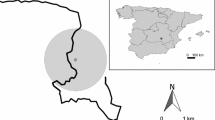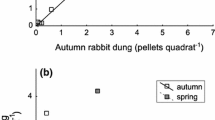Abstract
The European rabbit (Oryctolagus cuniculus) is among the 100 most harmful invasive alien organisms worldwide designated by the International Union for Conservation of Nature. Therefore, the Argentine government officially declared this species as being detrimental to biodiversity conservation. Rabbits represent a potential threat to the regeneration of Patagonian forests, which host unique biodiversity and functional relationships. However, two local studies that evaluated diet composition using microhistological analysis of feces in the north and south of Patagonian forests found that trees represent a small proportion of the annual diet of rabbits. The objective of this study was to evaluate the impact of rabbits on saplings in an area of Patagonian forest with high rabbit densities. We sampled 294 saplings for rabbit herbivory in 20 1-ha forest plots adjacent to grasslands and shrublands in Lanin National Park, Argentina. No evidence of tree regeneration limitations was found in the affected stands, which concurs with the results of previous local studies on diet composition. Other anthropogenic impacts, such as domestic ungulate breeding, intentional fires, urban growth, and forestry, appear to represent more serious threats to Patagonian forests than rabbit herbivory.

Similar content being viewed by others
Data Availability
Not applicable data, on the table.
References
Aizen MA, Ashworth L, Galetto L (2002) Reproductive success in fragmented habitats: do compatibility systems and pollination specialization matter? J Veg Sci 13(6):885–892
Allmert T, Jeschke JM, Evans T (2021) An assessment of the environmental and socio-economic impacts of alien rabbits and hares. Ambio 51(5):1314–1329
Armesto JJ, Rozzi R, Caspersen J (2001) Temperate forests of North and South America. Global Biodiversity in a Changing Environment: Scenarios for the 21st Century, 223–249
Bonino NA, Borrelli L (2006) Variación estacional de la dieta del conejo silvestre europeo (Oryctolagus cuniculus) en la región andina de Neuquén, Argentina. Ecol Austral 16:7–13
Cooke B, McPhee S, Quentin H (2008) Rabbits: a threat to conservation and natural resource management. How to rapidly assess a rabbit problem and take action. Bureau of Rural Sciences, Australian Government, pp. 16
Dekker JJA (2007) Rabbits, refuges and resources. How foraging of herbivores is affected by living in burrows. PhD dissertation, Wageningen Universiteit, Wageningen, the Netherlands
Duffy SG, Fairley JS, O’Donnel G (1996) Biology and Environment: Proceedings of the Royal Irish Academy. 96B(2):69–75
Fa JE, Sharples CM, Bell DJ (1999) Habitat correlates of European rabbit (Oryctolagus cuniculus) distribution after the spread of RVHD in Cadiz Province. Spain Journal of Zoology 249(1):83–96
Forneris L (2014) Diagnóstico para el desarrollo del Turismo Rural Comunitario en el Parque Nacional Lanín
Galende GI, Pozzi C, Montes de Oca F (2013) El conejo europeo (Oryctolagus cuniculus): un nuevo invasor en el Parque Nacional Nahuel Huapi. Macroscopia 3:10–14
Galende GI, Raffaele E (2008) Space use of a non-native species, the European hare (Lepus europaeus), in habitats of the southern vizcacha (Lagidium viscacia) in Northwestern Patagonia, Argentina. Eur J Wildl Res 54:299–304
Godoy R, Romero R, Carrillo R (1994) Estatus micotrófico de la flora vascular en bosques de coníferas nativas. Rev Chil Hist Nat 67:209–220
Hagen BL, Kumschick S (2018) The relevance of using various scoring schemes revealed by an impact assessment of feral mammals
Holl KD, Quiros-Nietzen E (1999) The effect of rabbit herbivory on reforestation of abandoned pasture in southern Costa Rica. Biol Cons 87(3):391–395
Holl KD, Loik ME, Lin EH, Samuels IA (2000) Tropical montane forest restoration in Costa Rica: overcoming barriers to dispersal and establishment. Restor Ecol 8(4):339–349
Howard WE, Amaya JN (1975) European rabbit invades western Argentina. J Wildlife Manag 757–761
Huertas Herrera A, Toro-Manríquez M, Borrelli L, Lencinas MV, Martínez Pastur G (2022) Forage offering and seasonal intake comparisons to evaluate European rabbit threat in Nothofagus forests of southern Patagonia. Ecol Process 11(1):45
Iason GR, Manso T, Sim DA, Hartley FG (2002) The functional response does not predict the local distribution of European Rabbits (Oryctolagus cuniculus) on grass swards: experimental evidence. Funct Ecol 16(3):394–402
Jaksic FM, Yáñez JL (1983) Rabbit and fox introduction in Tierra del Fuego: history and assessment of the attempts at biological control of the rabbit infestation. Biol Cons 26:367–374
Kontsiotis VJ, Bakaloudis DE, Merou T, Xofis P (2015) Trophic ecology of the European wild rabbit Oryctolagus cuniculus on the Mediterranean island of Lemnos, Greece. Ecol Res 30:683–691
Lees CA, Bell JD (2008) A conservation paradox for the 21st century: the European wild rabbit Oryctolagus cuniculus, an invasive alien and an endangered native species. Mammal Rev 38(4):304–320
Lombardi L, Fernández N, Moreno S, Villafuerte R (2003) Habitat-related differences in rabbit (Oryctolagus cuniculus) abundance, distribution, and activity. J Mammal 84(1):26–36. https://doi.org/10.1644/15451542(2003)084%3c0026:HRDIRO%3e2.0.CO;2
Martins H, Milne JA, Rego F (2002) Seasonal and spatial variation in the diet of the wild rabbit (Oryctolagus cuniculus L.) in Portugal. J Zoology 258(3):395–404
Mazzini F, Relva MA, Malizia LR (2018) Impacts of domestic cattle on forest and woody ecosystems in southern South America. Plant Ecol 219:913–925
Otero A (1997) Umbrales ambientales limites para actividades turisticas. Area huechulafquen - parque nacional lanín. Argentina. Documenot de la Administración de Parques Nacionales
Piazza V, Garibaldi L, Kitzberger T, Chaneton E (2018) Impactos ecologicos del Ganado extensivo en bosques de coihue. Macroscopia 14- 19
Rusch VE, Varela SA (2019) Bases para el manejo de bosques nativos con ganadería en Patagonia Norte. Parte I Ediciones INTA
Ryan SA, Moseby KE, Paton DC (2003) Comparative foraging preferences of the greater stick-nest rat Leporillus conditor and the European rabbit Oryctolagus cuniculus: implications for regeneration of arid lands. Australian Mammalogy 25:135–146
Seijo F, Godoy MM, Guglielmin D et al (2020) Conflicting frames about ownership and land use drive wildfire ignitions in a protected conservation area. Environ Manage 65:448–462. https://doi.org/10.1007/s00267-020-01265-w
Somers N, D’Haese B, Bossuyt B, Lens L, Hoffmann M (2008) Food quality affects diet preference of rabbits: experimental evidence. Belg J Zool 138(2):170–176
Veblen TT, Kitzberger T, Raffaele E, Lorenz DC (2003) Fire history and vegetation changes in northern Patagonia, Argentina. Fire Clim Change Temp Ecosys West Am 265–295.
Vivanco L, Austin AT (2019) The importance of macro-and micro-nutrients over climate for leaf litter decomposition and nutrient release in Patagonian temperate forests. For Ecol Manage 441:144–154
Vivanco L, Rascovan N, Austin AT (2018) Plant, fungal, bacterial, and nitrogen interactions in the litter layer of a native Patagonian forest. PeerJ 6:e4754
Acknowledgements
We thank Camilo Rivas for his help with the tests conducted with the domestic rabbit. MHC is Senior Researcher of the Argentinean Research Council
Author information
Authors and Affiliations
Contributions
MHC conducted field work and wrote de manuscript. LR analyzed the photographs, prepared the figure and reviewed the manuscript
Corresponding author
Ethics declarations
Competing interests
The authors declare no competing interests.
Additional information
Publisher's Note
Springer Nature remains neutral with regard to jurisdictional claims in published maps and institutional affiliations.
Rights and permissions
Springer Nature or its licensor (e.g. a society or other partner) holds exclusive rights to this article under a publishing agreement with the author(s) or other rightsholder(s); author self-archiving of the accepted manuscript version of this article is solely governed by the terms of such publishing agreement and applicable law.
About this article
Cite this article
Cassini, M.H., Rivas, L. Lack of evidence of significant impact of European rabbits on Patagonian forest regeneration. Eur J Wildl Res 69, 74 (2023). https://doi.org/10.1007/s10344-023-01710-1
Received:
Revised:
Accepted:
Published:
DOI: https://doi.org/10.1007/s10344-023-01710-1




